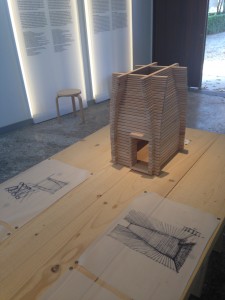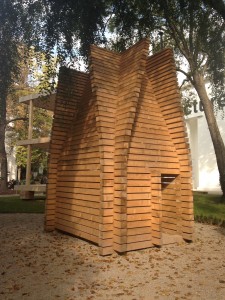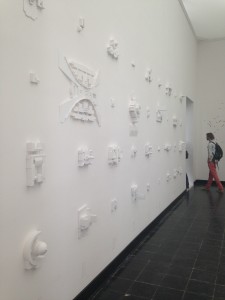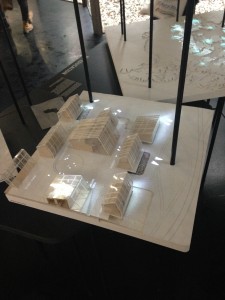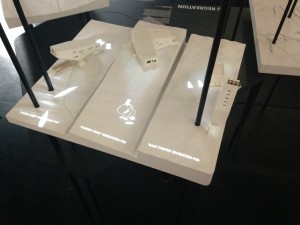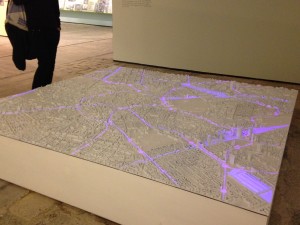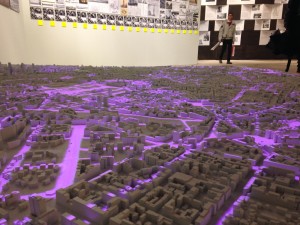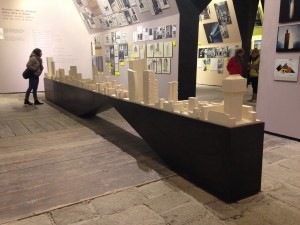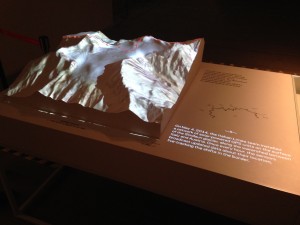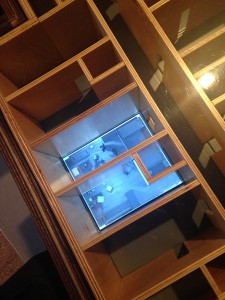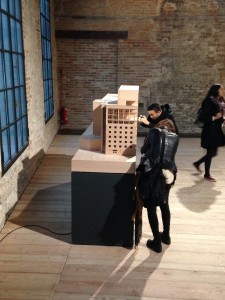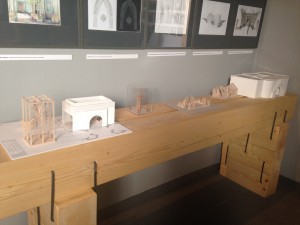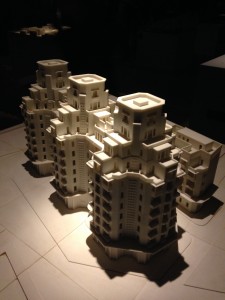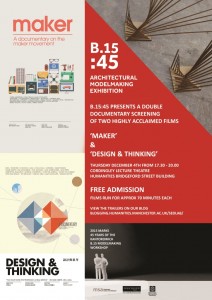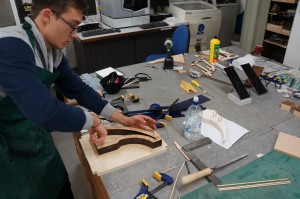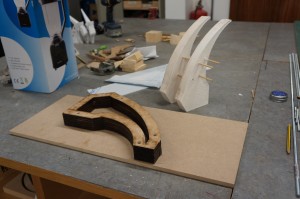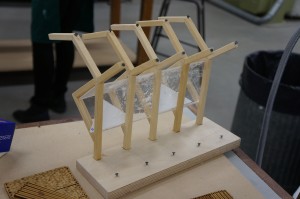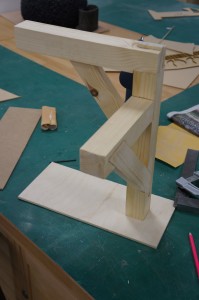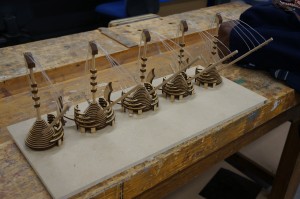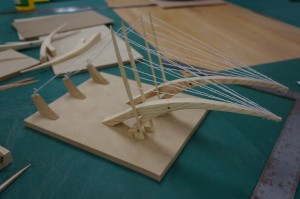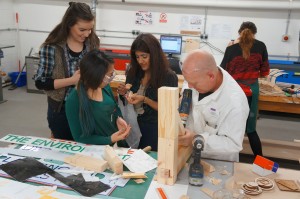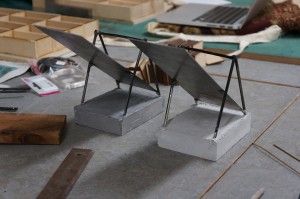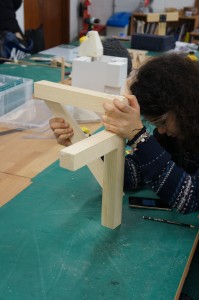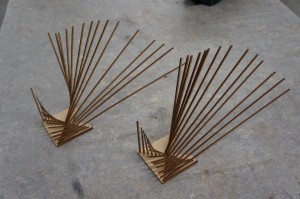The workshop will be closed between 09.30 and 13.00 on Tuesday 25th for planning inductions. Normal opening hours resume at 14.00.
Monthly Archives: November 2014
Venice Biennale 2014
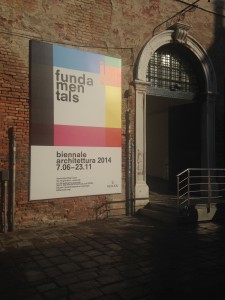 By now there have been hundreds of on-line reviews of the Venice Biennale which is this year focused around Architecture. The Venice Biennale is an annual event that showcases the creative arts from across the globe. Having been open since the start of June this year, the show is almost coming to its end having seen thousands of interested visitors of all backgrounds. My visit last week coincided with the 5th year study trip which basically allowed students free reign over the site and city.
By now there have been hundreds of on-line reviews of the Venice Biennale which is this year focused around Architecture. The Venice Biennale is an annual event that showcases the creative arts from across the globe. Having been open since the start of June this year, the show is almost coming to its end having seen thousands of interested visitors of all backgrounds. My visit last week coincided with the 5th year study trip which basically allowed students free reign over the site and city.
My interest on the site is of course about the varied use of models. There was certainly no shortage of examples. Each international pavilion display addressed their own study of architectural fundamentals and the use of models played a regular and prominent role. As there were so many examples I will summarize my visit by including images of the examples on show and pay particular attention to contemporary methods of display which noticeably inspired many of the students I was with.
Finland – This pavilion was curated in a clear a concise way that explained the concepts in drawings, writing, models and the full size buildings on display outside of the main space. This method of display for the project was great and makes for easy understanding by any visitor. It’s probably worth taking note of this narrative when thinking about the display or presentation of your own projects.
The use of timber pieces accurately cut for the model (above) translated directly into the construction of the 1:1 construction (right).
Austria – Now as popular as they are amongst established architects I’ve never been a huge fan of the ‘White Model’. I’m not sure why but I suppose it feels like a stark and almost clinical representation of a form which in reality has much more texture and thought behind its finish. That said, I’ve made many of these for clients and of course pursue the whitest of white finish to meet their brief. The Austrian pavilion presented a bright white room dotted with white block models of every one of the worlds parliament buildings (above left and below). I thought it was fantastic and enticing as did so many other visitors who spent a substantial amount of time examining the many models on display. This was an interesting subject matter to study in model form due to the ‘god’ like decisions that come from each of these buildings across the globe. One of my favourite displays of the show.
Projection Models – There was a noticeable buzz around the use of projectors to animate aspects of otherwise static models from the students I was with. Whilst this is something we have looked into before there were several good examples used across the Biennale.
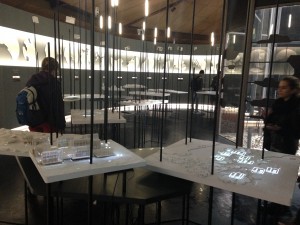 The Canadian pavilion made extensive use of the projection model with micro projectors mounted above white site models. Each model showed traffic flow trends and potential variants in the environment around the site. Anyone wanting to attempt a similar project should start by looking at the type of projector you want to use as they can be expensive and planning their set up in relation to the model is crucial.
The Canadian pavilion made extensive use of the projection model with micro projectors mounted above white site models. Each model showed traffic flow trends and potential variants in the environment around the site. Anyone wanting to attempt a similar project should start by looking at the type of projector you want to use as they can be expensive and planning their set up in relation to the model is crucial.
The Italian pavilion made use of a similar projection set up but was across a master plan model showing city routes toward and around particular hubs of activity.
Also on display in the Italian Pavilion was a host of plaster cast models (right) each with a high level of finish and detail that guaranteed a closer inspection from anyone who walked into the room.
This alpine mountain range model (left) made using a CNC router worked fantastically when OS maps were projected on the the model from directly above. the contouring matched perfectly and appeared almost hologram like in front of the viewer.
Russia – In the Russian pavilion there was an interesting model on show that combined digital animation with a physical model. The basic walls and elevations of the model were built up out of plywood and overlaid on top of screens with animated environments of the proposed interior spaces (left).
Turkey – There was a fantastic presentation cross section model of a theatre which was finished in veneer and full lighting (below). As is usually the case with models of this size they invite you to almost get inside the building and view different perspectives as you choose. This model was one of the best in show in terms of attention to detail and finish quality.
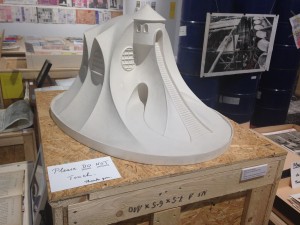 Japan – This display reminded me of a studio workspace with samples from different stages of the design process on display all over the room. Amongst the items were plaster casts (left) and perhaps interesting for our second and third year students at the moment, 1:1 structural details such as this fantastic timber joint detail below.
Japan – This display reminded me of a studio workspace with samples from different stages of the design process on display all over the room. Amongst the items were plaster casts (left) and perhaps interesting for our second and third year students at the moment, 1:1 structural details such as this fantastic timber joint detail below.
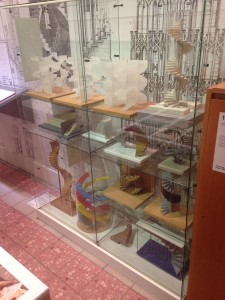
The main ‘Fundamentals of Architecture’ display by Rem Koolhass contained a fantastic array of different design and building components split it to groups and stages of production. One of the rooms featured a wide range of concept models from spiral stair cases (right). These were produced in different materials and at varied levels of finish but all as intriguing to see as each other.
The Hungarian Pavilion featured a number of great drawings and subsequent sketch models (left). These were made from a variety of materials and almost 100% using traditional analogue methods – that means no laser cutting guys! 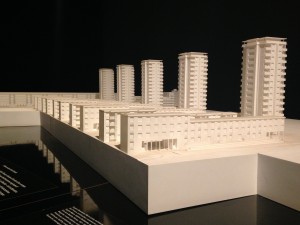
A huge part of the display in the French Pavilion looked at the tower block housing development called Cite De La Muette. The site was a modernist development that became synonymous with sadness after it was converted into a major internment camp for persecuted French Jews awaiting deportation during WW2.
 The exhibition looked at the values and goals the development originally set out to achieve that were unfortunately very short lived. The center piece of the display was a white presentation model of the site with a romanticized film vision of modernist living projected behind (left).
The exhibition looked at the values and goals the development originally set out to achieve that were unfortunately very short lived. The center piece of the display was a white presentation model of the site with a romanticized film vision of modernist living projected behind (left).
Conceptual presentation model on display in the Costa Rican Pavilion (below)
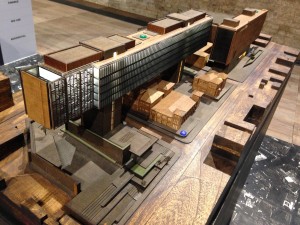 I can’t say I’m a huge fan of the design but this Korean hotel model was finished to a high standard from beech veneer and timber (below). Very nice.
I can’t say I’m a huge fan of the design but this Korean hotel model was finished to a high standard from beech veneer and timber (below). Very nice.
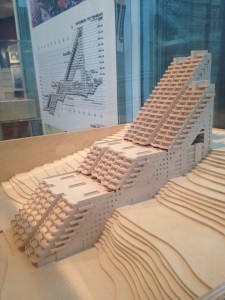 One of the 3d printed models from the Moroccan Pavilion display (below). A series of site models were displayed under spotlights in a sand filled dark room. Quite a strange experience to walk around.
One of the 3d printed models from the Moroccan Pavilion display (below). A series of site models were displayed under spotlights in a sand filled dark room. Quite a strange experience to walk around.
Interestingly, despite its increasing prominence in people’s consciousness both professional and public, the use of 3D printing was thankfully kept to an appropriate level in most cases. I was particularly glad of this as the repeated use of this method of model production can become somewhat boring!
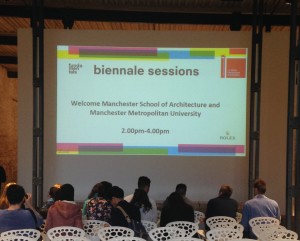
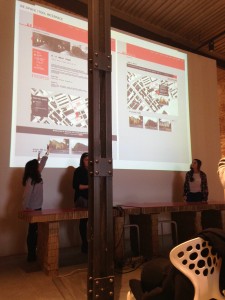 As well as the endless exploring of exhibitions across Venice the visiting students did manage to get a tutorial or two in and a presentation session of their proposed ideas.
As well as the endless exploring of exhibitions across Venice the visiting students did manage to get a tutorial or two in and a presentation session of their proposed ideas.
The show was a fantastic display and I would encourage anyone to visit and see as much of it as possible next time around. The city is, without really needing to say, a fantastic inspiration and learning experience in itself.
Workshop Closing at 15.30 on Tuesday 18th November
The workshop will close an hour early at 15.30 on Tuesday 18th November. We will be open as normal from Wednesday 19th November at 09.30.
B.15:45 PRESENTS: ‘MAKER’ & ‘DESIGN & THINKING’ DOCUMENTARIES SCREENING, THURSDAY 4TH DECEMBER
As part of our ongoing look at the role of Modelmaking in design, B.15:45 presents a screening of two highly acclaimed documentaries on the design and making field.
The two documentaries will be shown back to back from 17.30 on Thursday 4th December in the Cordingley Lecture Theatre in Humanities Bridgeford Street Building (Kantorowich Building where the B.15 Workshop and Exhibition are located)
Each film lasts approximately 70 minutes.
FREE ADMISSION
Here is an overview and trailer for each film:
Maker
‘Maker’ is a feature-length documentary that looks into the current maker movement in America – a new wave of Do-It-Yourself and Do-It-Together fueled by passion and powered by the advent of new technologies.Â
The ‘Maker Movement’, sometimes called the ‘Third Industrial Revolution,’ subverts traditional manufacturing by building on innovative concepts such as open source, local manufacturing, crowd funding, and digital fabrication. Breaking the hobbyist movement stereotype, ‘Maker’ delves deep into this ecosystem of design and manufacturing in the Internet era. The film explores the ideas, tools, and personalities that are driving the Maker Movement – and returns with a timely snapshot of one of the transforming influences of the current age.Â
Design & Thinking
Inspired by design thinking, this documentary grabs businessmen, designers, social
change-makers and unlikely individuals to portray what they have in common when
facing this ambiguous 21st century.
Synopsis:
How do we fully engage organizations to think about the changing landscape
of business, culture and society? Inspired by design thinking, this documentary grabs
businessman, designers, social change-makers and unlikely individuals to portrait
what they have in common when facing this ambiguous 21st century. What is design
thinking? How is it applied in business models? How are people changing the world
with their own creative minds? It is a call to the conventional minds to change and
collaborate.
2nd Year Creative Constructs: In Isolation Brief
The last two weeks have been extremely busy in the workshop thanks to the 2nd year Creative Constructs briefs. By producing a series of models, each taking the idea to a more defined level of explanation, students are expected to demonstrate their understanding of aspects of structural design. These should include understanding of scale, junction detailing, overall strength of the structure and their ability to be repeated to work in conjunction with identical components.
Many of the projects we’ve seen for this brief have followed the trends of others in the group who have made a quick start. This has been an issue for latecomers due to the time restraints and capacity of the workshops both here and Chatham.
For students taking part in this project in future it’s worth noting the time involved in producing these projects. Many of you have been surprised at the amount of thought required to make your models a reality though really this shouldn’t come as a shock as that thought is essential to your learning. By taking the time early on to think about the different aspects of your idea and defining them accurately you can then take your information and apply those defined ideas to the creation of your model.
Without defined constraints you are simply guessing or making aspects of your project up on the spot which isn’t really helping you to learn anything. You should be able to explain the use of particular joints of construction methods based on research rather than their aesthetic or convenience to make as a model. There have been some interesting ideas appearing so far and I’m sure they’ll be more to come!
Scott
Gaudi: Architecture Ahead of its Time Exhibition, Vienna
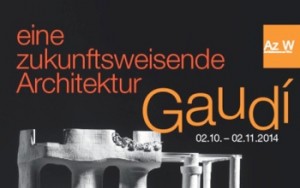 During a recent trip to Vienna I was lucky to catch the last day of an exhibition of the works of Gaudi at the Architekturzentrum Wien. The exhibition consisted of examples of furniture design alongside descriptions, slide shows of the major works and of course models.
During a recent trip to Vienna I was lucky to catch the last day of an exhibition of the works of Gaudi at the Architekturzentrum Wien. The exhibition consisted of examples of furniture design alongside descriptions, slide shows of the major works and of course models.
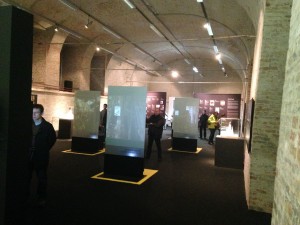 Of particular interest to our cause were the plaster models showing details and sections through parts of his buildings. The quality of these pieces was stunning and the photographs I was able to take really don’t do them justice.
Of particular interest to our cause were the plaster models showing details and sections through parts of his buildings. The quality of these pieces was stunning and the photographs I was able to take really don’t do them justice.
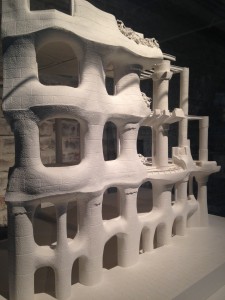 We can take from them is inspiration and a demonstration of the sort of insights models of this type can give us into the form and construction of a building. From my best insights a would say that models have been cast in sections and fitted together afterwards due to the fragility and complex shape of certain details. This method of Modelmaking requires the main focus on planning with a conscious thought for the casting process at all times. Martial tolerance and shrinkage is a key factor in designing parts to a particular size for assembly after casting.
We can take from them is inspiration and a demonstration of the sort of insights models of this type can give us into the form and construction of a building. From my best insights a would say that models have been cast in sections and fitted together afterwards due to the fragility and complex shape of certain details. This method of Modelmaking requires the main focus on planning with a conscious thought for the casting process at all times. Martial tolerance and shrinkage is a key factor in designing parts to a particular size for assembly after casting.  This facade section model of ‘La Pedrera’ in Barcelona shows the layers of supporting structure and outer form beautifully. In addition to the physical properties of the building demonstrated through the design, the shadows cast through window openings clear and defined giving accurate projections of how the interior space may change throughout the day.
This facade section model of ‘La Pedrera’ in Barcelona shows the layers of supporting structure and outer form beautifully. In addition to the physical properties of the building demonstrated through the design, the shadows cast through window openings clear and defined giving accurate projections of how the interior space may change throughout the day. 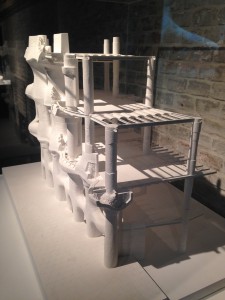
 Part of the exhibition text explained the importance of models to any project Gaudi embarked on:
Part of the exhibition text explained the importance of models to any project Gaudi embarked on:
‘Gaudi put models before plans. For this reason he set up a workshop next to each of his buildings, where he studied and analysed, from as empirical and a craftsman’s point of view, the forms and structures that he later applied to his projects. This is what he called his “experimental method”, a method that is still in use in the Sagrada Familia Workshop although these days this process has been enhanced with the most advanced technological instruments.’ (Daniel Giralt-Miracle, Curator of the Exhibition)
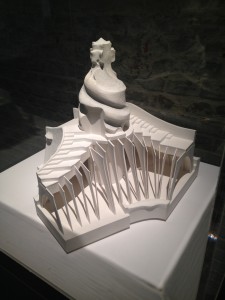 Due to our restricted casting capability in B.15 we will be focusing on the accurate production of the ‘master models’ in a manner suited for molding and casting at the Chatham casting facility. As with all projects, consult myself or Jim as early as possible to achieve the most effective results in your time frame. If the project is too difficult at a later stage a high quality finish will be harder to achieve so don’t hesitate to start on receiving your brief.
Due to our restricted casting capability in B.15 we will be focusing on the accurate production of the ‘master models’ in a manner suited for molding and casting at the Chatham casting facility. As with all projects, consult myself or Jim as early as possible to achieve the most effective results in your time frame. If the project is too difficult at a later stage a high quality finish will be harder to achieve so don’t hesitate to start on receiving your brief.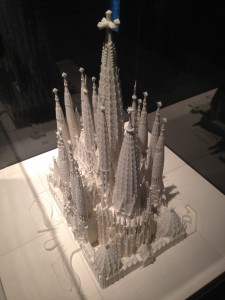 Also on display was this model 3D powder printed model of the entire Sagrada Familia (above). Producing a model of such complexity as a plaster cast would be achievable but in this case the powder printed method was chosen. Most likely due to the sophistication of each ‘spire’ component and it’s relationship to the next. Certainly for the conservation of time and as a retrospective piece this is very appropriate.Â
Also on display was this model 3D powder printed model of the entire Sagrada Familia (above). Producing a model of such complexity as a plaster cast would be achievable but in this case the powder printed method was chosen. Most likely due to the sophistication of each ‘spire’ component and it’s relationship to the next. Certainly for the conservation of time and as a retrospective piece this is very appropriate. 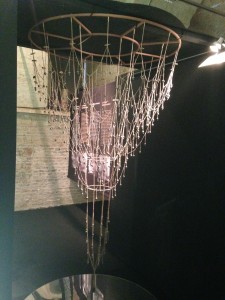 The above prototype testing model or stereo-funicular model is a replica of that used by Gaudi to develop his design for the construction of the crypt of the Colonia Guell. Simple materials like lead weights, string and a frame were crucial aids to design in Gaudis workshops and demonstrate the value of simple methods of creation or problem solving through making.
The above prototype testing model or stereo-funicular model is a replica of that used by Gaudi to develop his design for the construction of the crypt of the Colonia Guell. Simple materials like lead weights, string and a frame were crucial aids to design in Gaudis workshops and demonstrate the value of simple methods of creation or problem solving through making.
I’m glad I was able to catch this exhibition and would recommend anyone to drop by the Architekturzentrum Wien (Vienna) if they are in the city. Although it has now finished you can view the exhibition page here.
Scott


